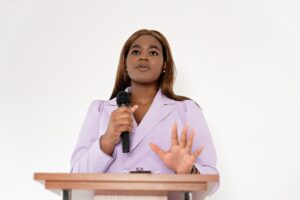Women’s Voices Matter
Women’s voices matter, what allies need to know
In my work advancing women’s leadership in the workplace by engaging men, a foundational principle we discuss is that all people’s voices must be heard in order to solve the complex business problems that exist today. Best practices data proves time and again that a diverse workforce provides the competitive advantage and long-term business success that organizations are looking for. Unfortunately, women’s voices are often underplayed and dismissed in the workplace. Two of the most common microaggressions reported by women have to do with being interrupted while speaking and having men take credit for their ideas.
Because of these enduring barriers to women’s voices being heard, I was fascinated by Dana Rubin’s new book, Speaking While Female: 75 Extraordinary Speeches by American Women. I wanted to ask her some questions about her project and the role that male allies may have played throughout history.

1) Tell us about your book and what led you to take on this project?
I’m a consultant, speechwriter, and speaker who’s on a mission to encourage more women to speak in public and put their views into the world. In recent years I’ve become aware of the extent to which women’s speeches have been overlooked in history. When we think about great speakers in history, we think about the men, because that’s what our history books have told us. But women have also been speaking! It wasn’t just the “great men” who gave all the greatest speeches. Women too have been changing the world with their public voices. It’s time we set the record straight.
Women too have been changing the world with their public voices.
To that end, over the past five years I’ve been working on an ongoing project, the Speaking While Female Speech Bank (SpeakingWhileFemale.co). This is a free online archive with thousands of speeches by women from across time and around the world. Teachers from high school to university level across the country are using it to fill in the gaps in their textbooks and course materials.
I’ve also just published the anthology, Speaking While Female: 75 Extraordinary Speeches by American Women, which tries to set the record straight about whose voices helped shape the nation’s ideas and institutions. This book traces the history of women’s public voice in America, from 1637 to 2021, and shows the vibrant diversity of women who have contributed to the national discussion.
2) How did you determine which voices and speeches to include?
I was very practical — I used an Excel spreadsheet. I needed a clear and simple way to keep track of so many women speakers over four centuries. Since my goal was to show that women had always been speaking in American history, I let chronology dictate my first round of selections.
The earliest recorded public words by a woman in America were by Anne Hutchinson. She was tried for heresy in 1637 in the Massachusetts Bay Colony for the crime of speaking about theological matters in the privacy of her own home. She was first, so I put her at the top of the spreadsheet. And then I continued on from there, filling in the spaces, through the decades, touching on all the major issues and causes that engaged women speakers: education, abolition, temperance, the Civil War, Reconstruction, World War I, women’s suffrage, and so on, up to the present.
My second guiding principle was diversity. I wanted to show the vibrant range of American women’s voices — including Black, White, Asian-American, Indigenous and Latina voices. And diversity of ethnic background, class and viewpoint. I also made sure to include speeches by women from across the political spectrum: left, right, and center.
3) Do you have a favorite speech that resonated with you as you did your research and writing?
That’s probably the question I get asked the most, and my answer is always the same: No! I’m constantly adding more speeches to the Speaking While Female Speech Bank and I consistently seem to fall in love with the last speech I just entered.
Every time I discover a new speech, it opens up an entirely new world, and new questions emerge — Who exactly was this woman? What was the cause that impassioned her? Why did she care so much about it? What was the historic context? How did her spoken words make an impact? Each question leads to new questions and new avenues to explore. Faced with so many revelations constantly unfolding about the complexity and nuances of American oratory, how could I possibly choose a favorite?
4) We know that women’s voices have historically been discounted and overlooked. Do you have an example of how strong male allyship helped elevate a woman’s voice and provide an opportunity to speak at an important moment in history?
Yes, there are so many! History is filled with examples of women who worked hand-in-hand with male allies to introduce new ideas, advance reforms and speak out for humanity.
Just a few examples: The great American abolitionist and orator Frederick Douglass attended the 1848 women’s rights convention in Seneca Falls, New York, and spoke eloquently in favor of the cause. His endorsement and presence helped bring more visibility and credibility to the cause, so that women like his friends Elizabeth Cady Stanton and Lucretia Mott could steer their campaign forward.
Henry Blackwell was one of the founders of the American Woman Suffrage Association and fell in love with Lucy Stone when he heard her speak at an antislavery meeting. When they married in 1855, they agreed that each would enjoy personal independence and autonomy, and he enthusiastically supported Stone to go against prevailing customs and keep her own surname, even when that caused a vicious public backlash. He fully supported Stone’s tireless public speaking on abolition, women’s rights, and human rights.
In contemporary times, Ziauddin Yousafzai is a poet, educator and man who oversaw a chain of private schools in Pakistan. Despite the growing influence of the Taliban, he encouraged his only daughter Malala to learn about politics and get an education. Of course, we know what happened — because she insisted on speaking in public about girls’ education, Malala was targeted and shot in the head by the Taliban. She has gone on to become a global humanitarian, an advocate for girls’ education and women’s rights, and a Nobel Prize winner.
5) What lessons can we take from male allies of the past and apply to today? What changes need to be made in order to be more effective male allies?
I believe the most profound lesson to draw from the past is that there is room for all voices in the public conversation — that we NEED all voices. We face so many profound and seemingly intractable problems — from the environment to government to global conflict. We can’t possibly address these issues in a meaningful way without the benefit of the knowledge, expertise and insight of everyone, women and men alike.
It took men and women working together as allies to achieve the meaningful gains of the past and get us to where we are today. When we take a hard look at the past, we see that nothing was accomplished without allyship. By looking back we can see how far we’ve come, through the force of that allyship, and recognize that the future is in our hands.
6) Is there anything else you would like to add?
What I hope people take away from this project is a fuller understanding of who contributed to creating the world we inhabit and whose voice matters. I would especially like young men and women to take away a message of inspiration.
Looking back we can admire and marvel at how many individuals spoke out and helped create the world we inhabit today. The lesson for today is clear. If those people could speak out then, when circumstances were more challenging and opportunities for using your voice harder to find, surely we can do it now. We need everyone to come forward and put their insights, their expertise, and their intellectual firepower into the world. We can’t afford to leave anyone out of the conversation.
Image credit: Pexels/Mikhail Nilov

